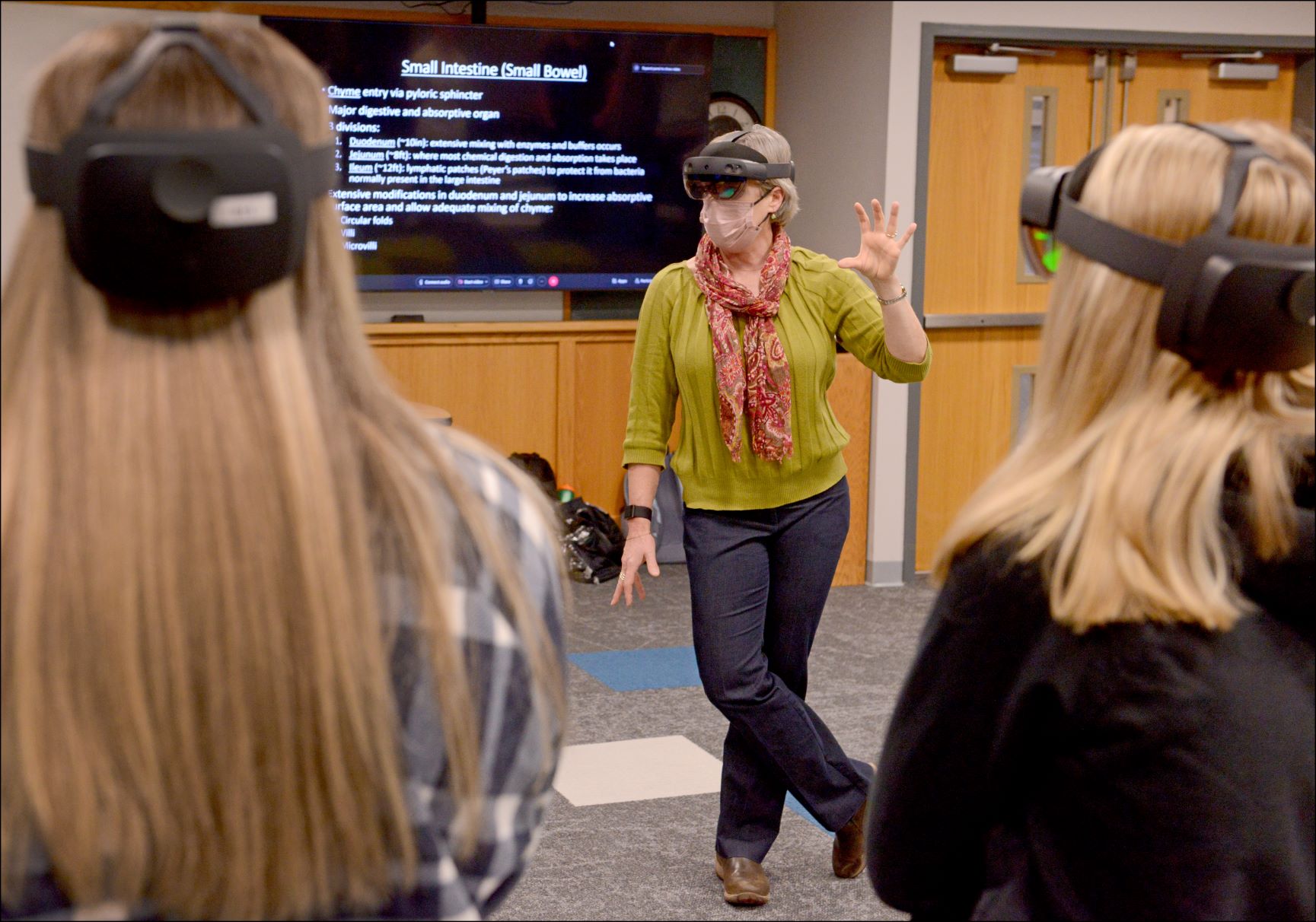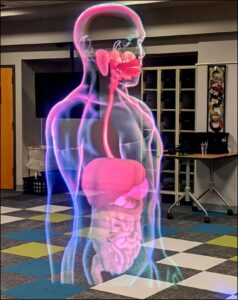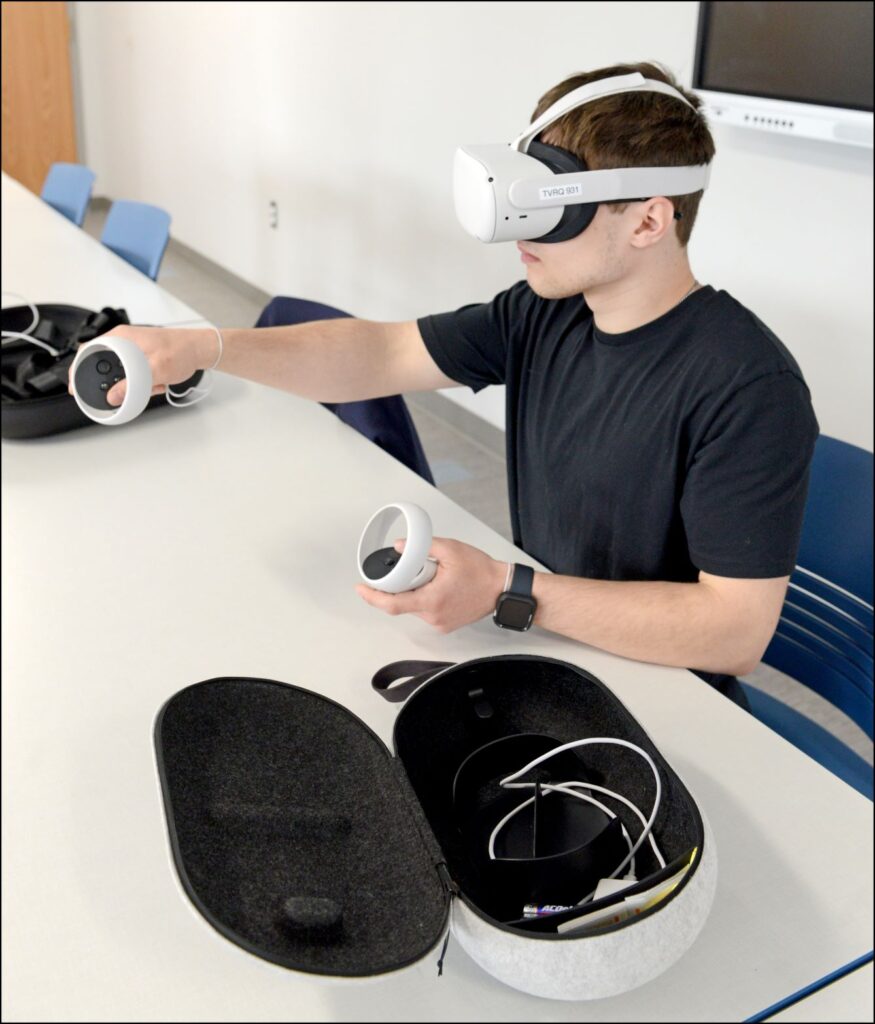
FLCC uses both virtual reality and mixed reality in educational programming. The technologies are similar with a few key differences.
Mixed reality
In 2018, the College began using three-dimensional holography to enhance the teaching of human anatomy and physiology, a required class for several programs: nursing, kinesiology and human performance, health care studies, physical education and exercise science, and nutrition and dietetics.
Under the guidance of Christine Parker, associate professor in biology, students wear Microsoft HoloLens visors in labs. The headset uses the HoloAnatomy Software Suite developed by Case Western Reserve University in conjunction with the Cleveland Clinic. This software enables students to view highly detailed, three-dimensional images of human organs individually and as part of body systems.

The university’s software allows the HoloLens to project a holographic image that everyone wearing the visors – students and their instructor – can see. The instructor can rotate the image, zoom in on a particular section or zoom out to show the class how structures function and interconnect.
In the labs, students work collaboratively in groups and view the same holographic image. Christine moves about the room, joining each group and pointing out features. Students can still see each other and the rest of the room behind the image.
They cannot manipulate the image though they can walk closer to it and even poke their heads inside to get an internal view of a particular structure. This is helpful, for example, to understand how the flow of blood proceeds through the human heart and then out to the general circulation. This three-dimensional approach helps students visualize key physical relationships between body structures.
FLCC is the only community college working with Case Western Reserve on the holography project. The university asked Christine to present on her use of the tool at the Microsoft HoloLens Education Industry Forum. The HoloAnatomy Software Suite is being used by medical schools around the world to redefine medical education.
Christine is tracking the impact of mixed reality on various aspects of student learning. When used during the instruction of a musculoskeletal unit, preliminary data suggest that HoloAnatomy improves student performance on bone and muscle exams compared to students who did not use the technology. She is expanding the use of mixed reality into additional content modules and course sections, and further classroom research efforts are underway.
Mixed reality is similar to augmented reality in that users can still see and hear their surroundings. Augmented reality provides some additional information within the field of view, for example, a cyclist wearing glasses showing speed, etc., while mixed reality allows for some limited interaction.
Virtual reality

In 2022, the College’s Workforce and Career Solutions office piloted virtual reality as part of a 16-week certified production technician (CPT) class, which teaches basic skills in advanced manufacturing.
Classes were offered in real time via videoconferencing with instructor Rick Hill. Students participated from their homes and two community sites, the Bloomfield School District Operations Center and the Yates County Workforce Development Office in Penn Yan. In-person labs were conducted on Saturdays and included virtual reality headsets and hand tools.
Unlike mixed reality, students are entirely immersed in an artificial setting, in this case a manufacturing plant. With the visors on, students cannot see others or the room around them, so the lesson always begins with a student selecting a safe space away from others and obstructions. Safety settings allow them to merely tap their headsets to stop the video feed.

With virtual reality, students have hand tools that allow them to interact with the artificial environment. For example, one exercise requires them to grip hand tools to learn the fundamentals of measurement.
Ron Jones of Bloomfield, Ontario County, said once he got used to the headsets, he enjoyed the experience, “especially the electrical troubleshooting module. I think it’s a great training tool when space and real equipment are unavailable.”
Virtual reality also allows people to learn safety measures without being in a dangerous environment, he added.
“The VR was fun. It did help with the hands-on part of class,” added fellow graduate Ken Sanford of Bradford, Yates County. “The VR helped to see what the tools are and how they work.”

